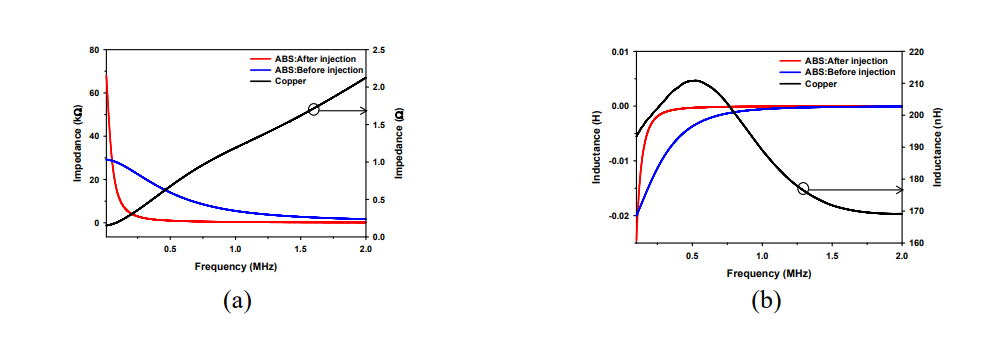In the recently published ‘3D printing of interdigital sensor based conductive ABS for salt and sucrose concentration sensing,’ authors W. Ponan and S. Harnsoongnoen outline their findings in fabricating integrated electronics.
The substrate and interdigital sensor were created with both ABS and conductive ABS filament, as the authors analyzed samples based on a direct current circuit. Because 3D printing is so centered around customization, it draws researchers, engineers, manufacturers, and users on every level who are interested in integrating electronics and completing projects more efficiently—often with ABS as their choice of material due to its conductivity.
Typically, applications include:
- Electronic ears
- Antennae
- Light-emitting diodes
- Sensors
So far, however, the authors explain that there have not been studies focused on sensor-based conductive ABS for salt and sucrose concentration sensing.

Interdigital conductive ABS sensor (a) structural layout (b) front view of fabricated sensor (c) back view of fabricated sensor (W = 4 mm, L1 = 65 mm, L2 = 70 mm and g = 2 mm).
The researchers used Esan3D Creator FDM 3D printers, with the following settings:
- Nozzle diameter of 0.4 mm
- Nozzle temperature of 260 °C
- Heated platform of 60 °C
Due to the use of copper and conductive ABS, the researchers handled impedance, with the studying showing:
- Impedance decreased with increased frequency
- Conductive ABS with 3D printing impedance is higher than that of conductive ABS injected by 3D printing
- Impedance of copper increased with increased frequency
In viewing the Nyquist plot for the conductive filaments, the researchers noted semi-circular impedance spectras, created from the capacitance of the conductive ABS filament. They also noted a definite connection as impedance of conductive ABS filament and conductive ABS filament injected by 3D printing increased when MUT was increased in length, resulting in impedance of all copper at 0.154 Ω. Electrical current also shifted, due to the salt and sucrose found in the deionized water concentration.
The authors listed regression value as 0.0433, with an R2 value of 0.9750. With sucrose in deionized water, it was -0.0033, with an R2 value of 0.9594.
“We showed that the 3D interdigital sensor based conductive ABS can be used to determine the concentration of salt and sucrose. The electrical current was observed and analyzed when there were changes in the concentrations of salt and sucrose in deionized water. The proposed technique has many advantages, such as wide dynamic range, high linearity, rapid measurement and lower-cost,” concluded the researchers.
Today, 3D printing is often associated with embedded electronics, sensors, and more—to include soft robotics and other complex processes.
Researchers, manufacturers, and innovative users around the globe are integrating sensors into wearables for prosthetics, embedding them in metal 3D printing, fabricating smart fibers, bioinspired innovations, and more.
What do you think of this news? Let us know your thoughts! Join the discussion of this and other 3D printing topics at 3DPrintBoard.com.
[Source / Images: ‘3D printing of interdigital sensor based conductive ABS for salt and sucrose concentration sensing‘]Subscribe to Our Email Newsletter
Stay up-to-date on all the latest news from the 3D printing industry and receive information and offers from third party vendors.
You May Also Like
3D Printing Unpeeled: New Arkema Material for HP, Saddle and Macro MEMS
A new Arkema material for MJF is said to reduce costs per part by up to 25% and have an 85% reusability ratio. HP 3D HR PA 12 S has been...
3D Printing News Briefs, January 20, 2024: FDM, LPBF, Underwater 3D Printer, Racing, & More
We’re starting off with a process certification in today’s 3D Printing News Briefs, and then moving on to research about solute trapping, laser powder bed fusion, and then moving on...
3D Printing Webinar and Event Roundup: December 3, 2023
We’ve got plenty of events and webinars coming up for you this week! Quickparts is having a Manufacturing Roadshow, America Makes is holding a Member Town Hall, Stratafest makes two...
Intuitive Machines Debuts $40M Hub for Lunar Ambitions and 3D Printing Tech
Best known for its pioneering work in lunar exploration and its development of the Nova-C lunar lander, Intuitive Machines (Nasdaq: LUNR) has marked yet another significant milestone. The leading space...


































